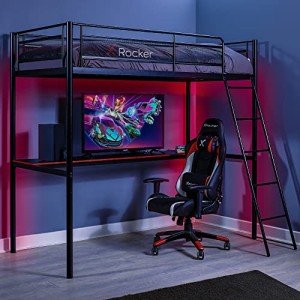The Comprehensive Guide to Bunk Beds House: Maximizing Space and Functionality
Bunk beds are ending up being increasingly popular in contemporary households, particularly for those living in restricted space. Whether in a kid's bedroom, a guest room, and even a villa, bunk beds provide an innovative service for taking full advantage of space while also accommodating numerous sleepers. This article explores the different elements of bunk beds, their design options, benefits, and considerations for maintenance to assist anyone considering a bunk bed purchase make a notified decision.
Understanding Bunk Beds
Bunk beds are a type of bed that includes one bed stacked on top of another, normally secured by a ladder or integrated stairs. They are typically made from wood or metal, with styles ranging from conventional to contemporary. Bunk beds are most frequently used in children's spaces, guest accommodations, and summer camps, but they can likewise be a great addition to small houses or homes.
Types of Bunk Beds
Understanding the ranges of bunk beds can assist one select the best design for one's requirements. Here are the common types:
| Type | Description | Pros | Cons |
|---|---|---|---|
| Standard Bunk | 2 beds stacked on top of each other | Space-saving, timeless style | Limited sleeping capability for adults |
| Loft Bed | A bed elevated with open space below for a work area or play area | Provides additional usable space | Not ideal for younger kids |
| Futon Bunk | A bed on top, typically with a futon on the bottom | Versatile for sleeping and seating | Less stability compared to traditional bunks |
| L-Shaped Bunk | 2 beds set up in an L-shape, often with storage choices | Distinct style, can suit corners | Takes up more space than basic bunk beds |
| Triple Bunk | Three beds arranged vertically or in an unique configuration | Makes the most of sleeping space | Greater threat of accidents, more complex to make |
Advantages of Bunk Beds
Bunk beds offer numerous advantages, making them a practical furniture choice for numerous living areas. The benefits include:
- Space Efficiency: Perfect for little rooms, they permit for more floor space, making it easier to move around.
- Double Functionality: Especially when it comes to loft-style beds, the space underneath can be used for a study location, a play zone, or extra storage.
- Social Interaction: Bunk beds produce a sense of camaraderie amongst brother or sisters or roomies, promoting sharing and bonding.
- Economical Sleeping Solution: They offer an inexpensive way to accommodate several visitors without the need to invest in extra different beds.
- Design Variety: With alternatives varying from smooth modern-day styles to timeless wood structures, there is a bunk bed design to match any design.
Important Considerations for Bunk Beds
While bunk beds offer numerous advantages, there are specific factors to consider to keep in mind to make sure safety and longevity:
- Weight Capacity: Always inspect the weight limit of the bunk bed to prevent mishaps. Most basic bunk beds have weight capacities in between 200-400 pounds.
- Product Quality: Opt for long lasting products such as solid wood or high-grade metal to make sure stability and longevity.
- Safety Features: Look for designs with guard rails on the leading bunk and wide ladders. Guarantee that the bed feet are stable and safe.
- Age Appropriateness: Young kids must not oversleep the top bunk, as the danger of falling is significantly increased.
- Assembly: Some bunk beds can be intricate to put together. Make rhettembt.top that good guidelines are readily available, or consider professional assembly.
Upkeep of Bunk Beds
Correct maintenance of bunk beds is vital for guaranteeing their comfort and safety. Here are some pointers for maintenance:
- Regular Inspections: Periodically check the stability of the bed, making sure all screws and components are tight and safe and secure.
- Cleaning up: Dust the furniture frequently and clean up any spills instantly to keep the stability and appearance of the beds.
- Bed mattress Care: Rotate mattresses periodically to prevent wear and drooping. Think about hypoallergenic bed mattress protectors for added convenience and cleanliness.
- Adjust if Moved: If the bed is transferred, readjust all elements to ensure ongoing security and stability.
FAQs about Bunk Beds
Q1: Are bunk beds safe for children?A1: Yes, as long as security standards are stuck to. Ensure the leading bunk has guardrails, which kids are old sufficient and responsible enough to securely use the top bunk. Q2: How much weight can a bunk
bed support?A2: Most bunk beds support between 200 to 400 pounds per bed
, however this can vary by design. Always describe the producer's specs. Q3: Can adults oversleep bunk beds?A3: Yes, numerous modern bunk beds are
developed to accommodate adults, particularly those with reinforced frames. Q4: Do bunk beds need special mattresses?A4: Not always. Requirement mattresses can be utilized as long as they fit the
measurements offered by the manufacturer. Nevertheless,
consider using thinner mattresses for the leading bunk to make sure safety clearance. Q5: How can I maximize space in a room with bunk beds?A5: Use the area underneath for storage or desks, and consider integrating vertical storage
options to keep the space uncluttered. Bunk beds provide an excellent option for optimizing space in a home while offering an elegant and practical sleeping plan. Whether for a kid's space, a visitor space, or a getaway house, they are a versatile choice that can accommodate numerous requirements. By considering types, benefits, and appropriate maintenance, people can make informed choices, making sure security and durability in their bunk bed financial investment. With mindful selection, bunk beds can improve both comfort and visual appeal in any space.

